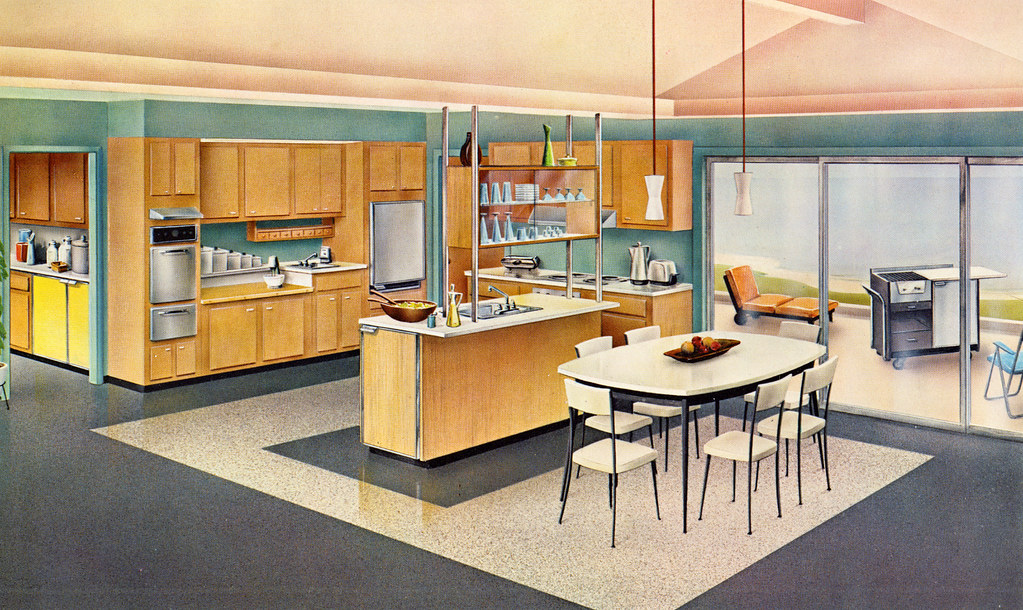Redoing a kitchen from the 1960s? Given that there were many changes during the 1960s, it’s not an easy process. The decade had a formal start and a quirky finish. That symbol of 1950s sensibility, Dwight D. Eisenhower, was still the U.S. Head of State. After a decade, the Age of Aquarius, Woodstock, and the Vietnam War occurred.
Trends of the day were mirrored in the architecture and interior design. Additionally, new resources were presented. Materials that are synthetic, such as Corian solid surface, were created. During the 1960s, the kitchen was one space that saw modifications. A kitchen from the early 1960s might be simple and angular, but a kitchen from ten years later might have striking colors and Space Age lines.
Take a look at some 1960s kitchen trends that you might want to use in your own kitchen renovation.
Wall Cabinets Hung From the Ceiling

In the 1962 kitchen design, sleek, wood-veneered wall cabinets were used to separate the kitchen from the dining area, showcasing a popular trend from the ’60s. Instead of being mounted on traditional walls, these cabinets were suspended from the ceiling, creating an open and airy space between the two rooms.
For standard 8-foot ceilings, the cabinets were supported by joists. In rooms with higher ceilings, additional support structures were necessary, with some extending from above and others rising from the base cabinets.
Solid Color Laminate Countertops
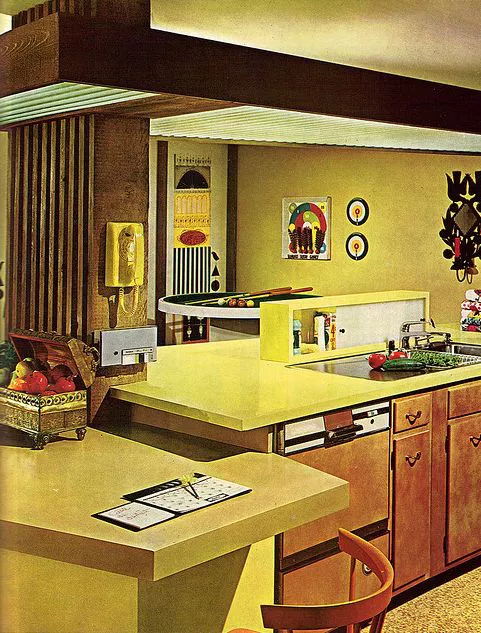
A notable feature from 1969 is the use of solid-color laminate countertops, such as the bold yellow seen in some kitchens. Major brands like Wilsonart and Formica provided these vibrant surfaces.
The intense colors were inspired by Pop Art figures like Andy Warhol and Roy Lichtenstein, infusing kitchens with a dynamic and energetic feel. Complementary bright hues were often incorporated into other kitchen elements such as appliances and fixtures.
Today, laminate countertops continue to be available in a range of solid colors.
Exposed Brick

Brick was a striking element in some ’60s kitchens, with cabinets framed in brick, brick half-walls, and exposed brick accents. Wall ovens were frequently built into brick alcoves.
Unlike the futuristic, synthetic materials popular in the ’60s, brick, copper, and wood offered a natural touch. The brickwork was often left unpainted, although some kitchens opted for painted finishes.
Slab Cabinet Doors

In the ’60s, slab cabinet doors and drawer fronts were favored for their sleek, minimalist look. Often, these doors featured smooth surfaces with minimal hardware, and some designs included grooves in place of traditional pulls or knobs.
In the latter part of the ’60s and into the ’70s, gold or green faux bottle-glass plastic was also popular in kitchens, adding a distinctive touch to cabinetry.
Natural Wood
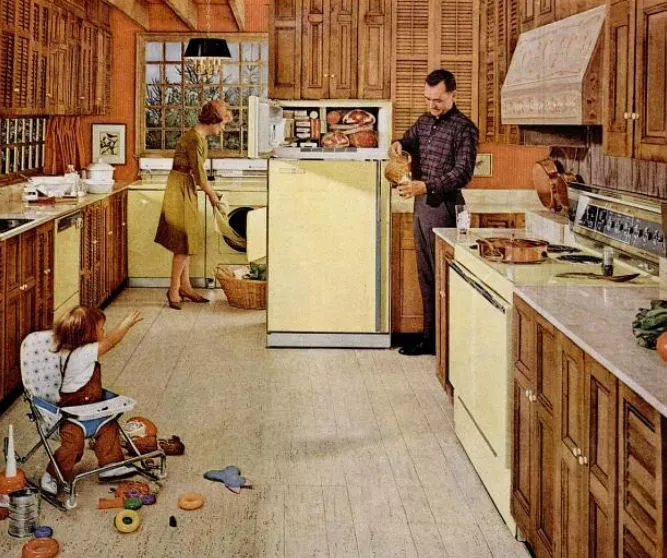
A 1960 kitchen with natural wood cabinetry exudes a timeless appeal that remains relevant today. The use of neutral-colored appliances, rather than the vibrant harvest yellow or avocado hues of the time, gives the space a more classic appearance.
If you’re updating a similar kitchen, consider options like resilient plank flooring (instead of real wood), engineered marble countertops, and faux wood beams for a contemporary twist.
Resilient Flooring
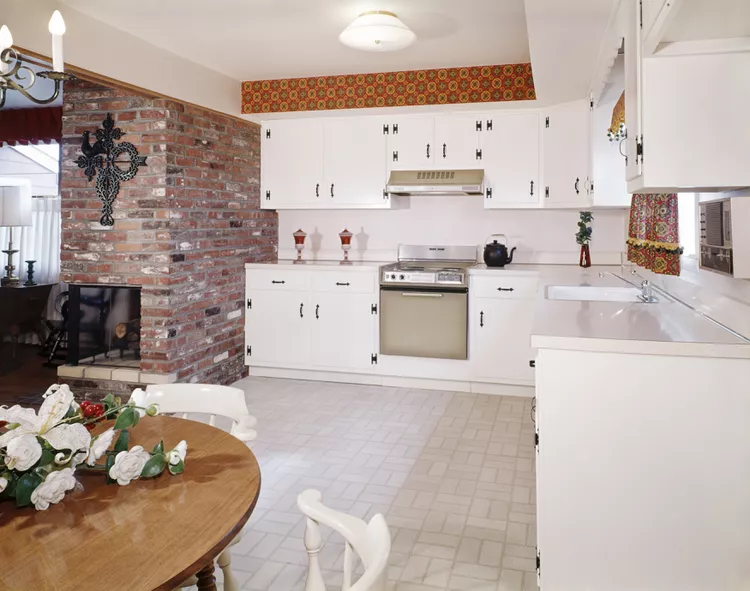
During the 1960s, resilient flooring, particularly in the form of sheet vinyl, gained popularity. Valued for its durability, water resistance, and ease of maintenance, this type of flooring was available in wide 12-foot rolls, covering small kitchen floors seamlessly.
Sheet vinyl could be printed with a variety of patterns and colors, including brick, marble, solid hues, wood, and faux tile, making it a versatile choice.
Bold Patterns
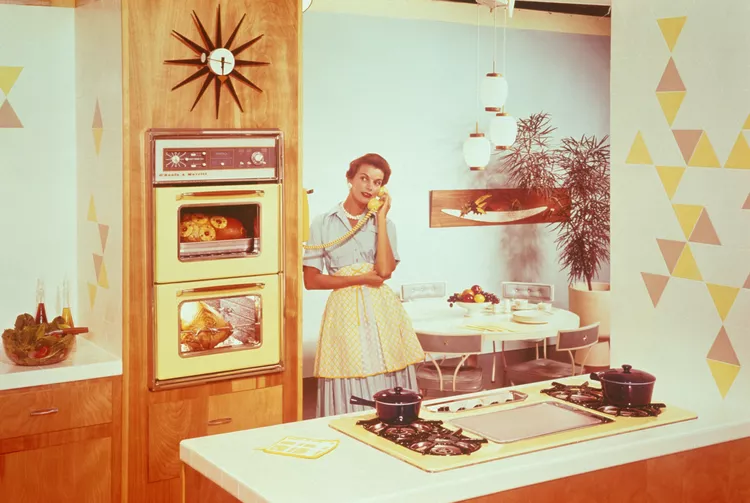
The ’60s kitchen was characterized by vibrant and eye-catching patterns. Designs featuring stars, triangles, chevrons, and boomerangs were commonly used on walls, often applied with paint rollers and masking tape.
Star-shaped kitchen clocks and Sputnik light fixtures were as iconic in these kitchens as the bold wall patterns.

